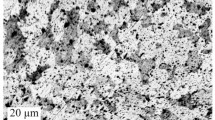We study the characteristics of hydrogen permeability of 10Kh9VFA and 12Kh18N10T reactor steels in the intact state and in the presence of welds and analyze the influence of oxidation and irradiation with protons on these characteristics. It is shown that the proton irradiation increases the thermal stability and the degree of protection against the penetration of hydrogen into the oxidized specimens. To determine the contribution of the welds to the solubility of hydrogen, we apply, for the first time, a combined approach, namely, the diffusion coefficient of hydrogen in the weld is found according to the changes in the electric resistance in the process of hydrogenation and the hydrogen permeability of the welded joint is determined from the ratio of the areas of the base metal and the weld. It is shown that the oxide films with structures of chromium spinel formed on the surface of steels decrease their hydrogen permeability by 1.5–2 orders of magnitude.
Similar content being viewed by others
References
V. I. Pokhmurs’kyi and V. V. Fedorov, Influence of Hydrogen on the Diffusion Processes in Metals [in Ukrainian], Karpenko Physicomechanical Institute, Ukrainian National Academy of Sciences, Lviv (1998).
V. V. Fedorov, R. I. Korolyuk, T. M. Zasadnyi, and Ya. M. Ivaniv, “Hydrogen permeability of EP-838 and Kh12G20V reactor steels after alloying and thermal treatment,” Mater. Sci., No. 4, 527–533 (2000).
P. Kofstad, High-Temperature Oxidation of Metals, Wiley, New York (1966).
I. V. Semchishin, R. I. Van’kovich, and B. F. Kachmar, A Procedure of Formation of Oxide Films [in Russian], Authors’ Certificate 338552 USSR, MKI s230 11/00, Publ. 15.05.1972, Bull. No. 16.
O. A. Val’dner, V. F. Gass, A. A. Glazkov, et al., “‘Uran’ linear resonance accelerator of protons for applied purposes,” Prib. Tekhn. Éksp., No. 5, 31–34 (1988).
V. P. Babaev, V. T. Zabolotnyi, L. I. Ivanov, et al., “Application of accelerators for the simulation of structure-and-phase transformations under the reactor irradiation,” Fiz. Khim. Obrab. Mater., No. 4, 16–19 (1988).
V. V. Fedorov, E. V. Dyomina, T. M. Zasadnyi, et al., “Hydrogen permeability over the joint weld of the steel parts of fusion reactor with magnet confinement of plasma,” J. Nucl. Mater., 307–311(0), 1498–1501 (2002).
Author information
Authors and Affiliations
Corresponding author
Additional information
Translated from Fizyko-Khimichna Mekhanika Materialiv, Vol. 45, No. 5, pp. 33–38, September–October, 2009.
Rights and permissions
About this article
Cite this article
Fedorov, V.V., Zasadnyi, T.M. Effect of modification of the surface on the hydrogen permeability of reactor steels and their welded joints. Mater Sci 45, 644–650 (2009). https://doi.org/10.1007/s11003-010-9226-z
Received:
Published:
Issue Date:
DOI: https://doi.org/10.1007/s11003-010-9226-z




